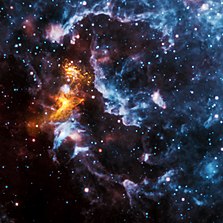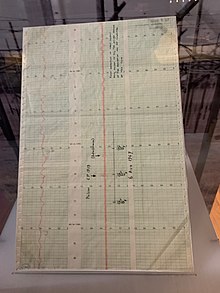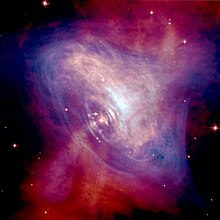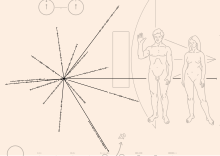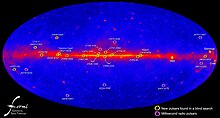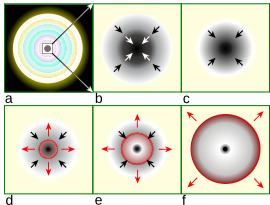
A neutron star is a collapsed core of a massive supergiant star. The stars that later collapse into neutron stars have a total mass of between 10 and 25 solar masses (M☉), possibly more if the star was especially rich in elements heavier than hydrogen and helium. Except for black holes, neutron stars are the smallest and densest known class of stellar objects. Neutron stars have a radius on the order of 10 kilometers (6 mi) and a mass of about 1.4 M☉. They result from the supernova explosion of a massive star, combined with gravitational collapse, that compresses the core past white dwarf star density to that of atomic nuclei.
Timeline of neutron stars, pulsars, supernovae, and white dwarfs
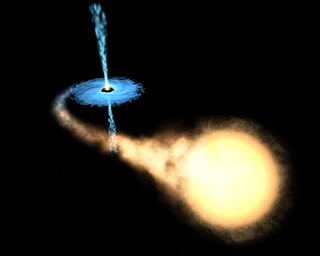
X-ray binaries are a class of binary stars that are luminous in X-rays. The X-rays are produced by matter falling from one component, called the donor, to the other component, called the accretor, which is either a neutron star or black hole. The infalling matter releases gravitational potential energy, up to 30 percent of its rest mass, as X-rays. The lifetime and the mass-transfer rate in an X-ray binary depends on the evolutionary status of the donor star, the mass ratio between the stellar components, and their orbital separation.
X-ray pulsars or accretion-powered pulsars are a class of astronomical objects that are X-ray sources displaying strict periodic variations in X-ray intensity. The X-ray periods range from as little as a fraction of a second to as much as several minutes.

Einstein@Home is a volunteer computing project that searches for signals from spinning neutron stars in data from gravitational-wave detectors, from large radio telescopes, and from a gamma-ray telescope. Neutron stars are detected by their pulsed radio and gamma-ray emission as radio and/or gamma-ray pulsars. They also might be observable as continuous gravitational wave sources if they are rapidly spinning and non-axisymmetrically deformed. The project was officially launched on 19 February 2005 as part of the American Physical Society's contribution to the World Year of Physics 2005 event.

The Crab Pulsar is a relatively young neutron star. The star is the central star in the Crab Nebula, a remnant of the supernova SN 1054, which was widely observed on Earth in the year 1054. Discovered in 1968, the pulsar was the first to be connected with a supernova remnant.

A millisecond pulsar (MSP) is a pulsar with a rotational period less than about 10 milliseconds. Millisecond pulsars have been detected in radio, X-ray, and gamma ray portions of the electromagnetic spectrum. The leading hypothesis for the origin of millisecond pulsars is that they are old, rapidly rotating neutron stars that have been spun up or "recycled" through accretion of matter from a companion star in a close binary system. For this reason, millisecond pulsars are sometimes called recycled pulsars.

PSR J0737−3039 is the first known double pulsar. It consists of two neutron stars emitting electromagnetic waves in the radio wavelength in a relativistic binary system. The two pulsars are known as PSR J0737−3039A and PSR J0737−3039B. It was discovered in 2003 at Australia's Parkes Observatory by an international team led by the Italian radio astronomer Marta Burgay during a high-latitude pulsar survey.
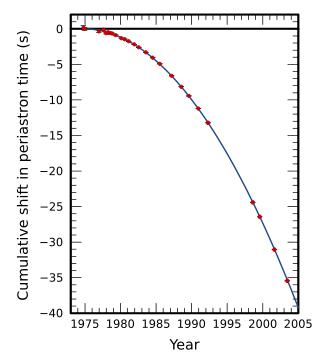
The Hulse–Taylor pulsar is a binary star system composed of a neutron star and a pulsar which orbit around their common center of mass. It is the first binary pulsar ever discovered.

A binary pulsar is a pulsar with a binary companion, often a white dwarf or neutron star. Binary pulsars are one of the few objects which allow physicists to test general relativity because of the strong gravitational fields in their vicinities. Although the binary companion to the pulsar is usually difficult or impossible to observe directly, its presence can be deduced from the timing of the pulses from the pulsar itself, which can be measured with extraordinary accuracy by radio telescopes.
PSR J1903+0327 is a millisecond pulsar in a highly eccentric binary orbit.
PSR J0437−4715 is a pulsar. Discovered in the Parkes 70 cm survey, it remains the closest and brightest millisecond pulsar (MSP) known. The pulsar rotates about its axis 173.7 times per second and therefore completes a rotation every 5.75 milliseconds. It emits a searchlight-like radio beam that sweeps past the Earth each time it rotates. Currently the most precisely located object outside of the Solar System, PSR J0437-4715 is 156.3 parsecs or 509.8 light-years distant.

PSR B1937+21 is a pulsar located in the constellation Vulpecula a few degrees in the sky away from the first discovered pulsar, PSR B1919+21. The name PSR B1937+21 is derived from the word "pulsar" and the declination and right ascension at which it is located, with the "B" indicating that the coordinates are for the 1950.0 epoch. PSR B1937+21 was discovered in 1982 by Don Backer, Shri Kulkarni, Carl Heiles, Michael Davis, and Miller Goss.
PSR J0108−1431 is a solitary pulsar located at a distance of about 130 parsecs (424 light-years) in the constellation Cetus. This pulsar was discovered in 1994 during the Parkes Southern Pulsar Survey. It is considered a very old pulsar with an estimated age of 166 million years and a rotation period of 0.8 seconds. The rotational energy being generated by the spin-down of this pulsar is 5.8 × 1023 W and the surface magnetic field is 2.5 × 107 T. As of 2008, it is the second faintest known pulsar.
PSR J1614–2230 is a pulsar in a binary system with a white dwarf in the constellation Scorpius. It was discovered in 2006 with the Parkes telescope in a survey of unidentified gamma ray sources in the Energetic Gamma Ray Experiment Telescope catalog. PSR J1614–2230 is a millisecond pulsar, a type of neutron star, that spins on its axis roughly 317 times per second, corresponding to a period of 3.15 milliseconds. Like all pulsars, it emits radiation in a beam, similar to a lighthouse. Emission from PSR J1614–2230 is observed as pulses at the spin period of PSR J1614–2230. The pulsed nature of its emission allows for the arrival of individual pulses to be timed. By measuring the arrival time of pulses, astronomers observed the delay of pulse arrivals from PSR J1614–2230 when it was passing behind its companion from the vantage point of Earth. By measuring this delay, known as the Shapiro delay, astronomers determined the mass of PSR J1614–2230 and its companion. The team performing the observations found that the mass of PSR J1614–2230 is 1.97 ± 0.04 M☉. This mass made PSR J1614–2230 the most massive known neutron star at the time of discovery, and rules out many neutron star equations of state that include exotic matter such as hyperons and kaon condensates.

PSR J1311–3430 is a pulsar with a spin period of 2.5 milliseconds. It is the first millisecond pulsar found via gamma-ray pulsations. The source was originally identified by the Energetic Gamma Ray Experiment Telescope as a bright gamma ray source, but was not recognized as a pulsar until observations with the Fermi Gamma-ray Space Telescope discovered pulsed gamma ray emission. The pulsar has a helium-dominated companion much less massive than itself, and the two are in an orbit with a period of 93.8 minutes. The system is explained by a model where mass from the low mass companion was transferred on to the pulsar, increasing the mass of the pulsar and decreasing its period. These systems are known as Black Widow Pulsars, named after the original such system discovered, PSR B1957+20, and may eventually lead to the companion being completely vaporized. Among systems like these, the orbital period of PSR J1311–3430 is the shortest ever found. Spectroscopic observations of the companion suggest that the mass of the pulsar is 2.7 . Though there is considerable uncertainty in this estimate, the minimum mass for the pulsar that the authors find adequately fits the data is 2.15 , which is still more massive than PSR J1614−2230, the previous record holder for most massive known pulsar.

PSR J0348+0432 is a pulsar–white dwarf binary system in the constellation Taurus. It was discovered in 2007 with the National Radio Astronomy Observatory's Robert C. Byrd Green Bank Telescope in a drift-scan survey.

PSR J0952–0607 is a massive millisecond pulsar in a binary system, located between 3,200–5,700 light-years (970–1,740 pc) from Earth in the constellation Sextans. It holds the record for being the most massive neutron star known as of 2022, with a mass 2.35±0.17 times that of the Sun—potentially close to the Tolman–Oppenheimer–Volkoff mass upper limit for neutron stars. The pulsar rotates at a frequency of 707 Hz, making it the second-fastest-spinning pulsar known, and the fastest-spinning pulsar known within the Milky Way.
PSR J1946+2052 is a short-period binary pulsar system located 11,000–14,000 light-years (3,500–4,200 pc) away from Earth in the constellation Vulpecula. The system consists of a pulsar and a neutron star orbiting around their common center of mass every 1.88 hours, which is the shortest orbital period among all known double neutron star systems as of 2022. The general theory of relativity predicts their orbits are gradually decaying due to emitting gravitational waves, which will eventually lead to a neutron star merger and a kilonova in 46 million years.

Pulsar planets are planets that are orbiting pulsars. The first such planets to be discovered were around a millisecond pulsar in 1992 and were the first extrasolar planets to be confirmed as discovered. Pulsars are extremely precise clocks and even small planets can create detectable variations in pulsar traits; the smallest known exoplanet is a pulsar planet.
